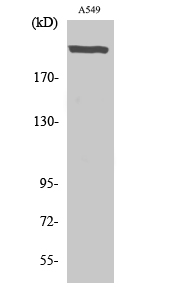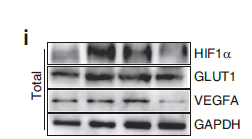
主要信息
Target
UBR5
Host Species
Rabbit
Reactivity
Human, Mouse
Applications
WB, IHC, IF, ELISA
MW
309kD (Observed)
Conjugate/Modification
Unmodified
货号: YT4809
规格
价格
货期
数量
200μL
¥3,780.00
现货
0
100μL
¥2,300.00
现货
0
40μL
¥960.00
现货
0
加入购物车


已收藏


收藏
详细信息
推荐稀释比
WB 1:500-1:2000; IHC 1:100-1:300; ELISA 1:5000; IF 1:50-200
组成
Liquid in PBS containing 50% glycerol, 0.5% BSA and 0.02% sodium azide.
特异性
UBR5 Polyclonal Antibody detects endogenous levels of UBR5 protein.
纯化工艺
The antibody was affinity-purified from rabbit antiserum by affinity-chromatography using epitope-specific immunogen.
储存
-15°C to -25°C/1 year(Do not lower than -25°C)
浓度
1 mg/ml
实测条带
309kD
修饰
Unmodified
克隆性
Polyclonal
同种型
IgG
相关产品
抗原&靶点信息
免疫原:
The antiserum was produced against synthesized peptide derived from human EDD. AA range:1-50
展开内容
特异性:
UBR5 Polyclonal Antibody detects endogenous levels of UBR5 protein.
展开内容
基因名称:
UBR5
展开内容
蛋白名称:
E3 ubiquitin-protein ligase UBR5
展开内容
别名:
UBR5 ;
EDD ;
EDD1 ;
HYD ;
KIAA0896 ;
E3 ubiquitin-protein ligase UBR5 ;
E3 ubiquitin-protein ligase ;
HECT domain-containing 1 ;
Hyperplastic discs protein homolog ;
hHYD ;
Progestin-induced protein
EDD ;
EDD1 ;
HYD ;
KIAA0896 ;
E3 ubiquitin-protein ligase UBR5 ;
E3 ubiquitin-protein ligase ;
HECT domain-containing 1 ;
Hyperplastic discs protein homolog ;
hHYD ;
Progestin-induced protein
展开内容
背景:
This gene encodes a progestin-induced protein, which belongs to the HECT (homology to E6-AP carboxyl terminus) family. The HECT family proteins function as E3 ubiquitin-protein ligases, targeting specific proteins for ubiquitin-mediated proteolysis. This gene is localized to chromosome 8q22 which is disrupted in a variety of cancers. This gene potentially has a role in regulation of cell proliferation or differentiation. [provided by RefSeq, Jul 2008],
展开内容
功能:
Function:E3 ubiquitin-protein ligase which is a component of the N-end rule pathway. Recognizes and binds to proteins bearing specific amino-terminal residues that are destabilizing according to the N-end rule, leading to their ubiquitination and subsequent degradation (By similarity). May be involved in maturation and/or transcriptional regulation of mRNA. May play a role in control of cell cycle progression. May have tumor suppressor function. Regulates DNA topoisomerase II binding protein (TopBP1) in the DNA damage response. Plays an essential role in extraembryonic development.,miscellaneous:A cysteine residue is required for ubiquitin-thioester formation.,pathway:Protein modification; protein ubiquitination.,PTM:Phosphorylated upon DNA damage, probably by ATM or ATR.,similarity:Contains 1 HECT (E6AP-type E3 ubiquitin-protein ligase) domain.,similarity:Contains 1 PABC domain.,similarity:Contains 1 UBR-type zinc finger.,subunit:Binds TOPBP1.,tissue specificity:Widely expressed. Most abundant in testis and expressed at high levels in brain, pituitary and kidney.,
展开内容
细胞定位:
Nucleus.
展开内容
组织表达:
Widely expressed. Most abundant in testis and expressed at high levels in brain, pituitary and kidney.
展开内容
研究领域:
>>Ubiquitin mediated proteolysis
展开内容
信号通路
文献引用({{totalcount}})
货号: YT4809
规格
价格
货期
数量
200μL
¥3,780.00
现货
0
100μL
¥2,300.00
现货
0
40μL
¥960.00
现货
0
加入购物车


已收藏


收藏
Recently Viewed Products
Clear allToggle night Mode
{{pinfoXq.title || ''}}
Catalog: {{pinfoXq.catalog || ''}}
Filter:
All
{{item.name}}
{{pinfo.title}}
-{{pinfo.catalog}}
主要信息
Target
{{pinfo.target}}
Reactivity
{{pinfo.react}}
Applications
{{pinfo.applicat}}
Conjugate/Modification
{{pinfo.coupling}}/{{pinfo.modific}}
MW (kDa)
{{pinfo.mwcalc}}
Host Species
{{pinfo.hostspec}}
Isotype
{{pinfo.isotype}}
产品 {{index}}/{{pcount}}
上一个产品
下一个产品
{{pvTitle}}
滚轮缩放图片
{{pvDescr}}






















